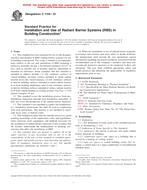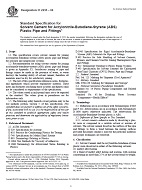1.1 This fire-test-response test method measures the performance of a unique fire resistive joint system called a continuity head-of-wall joint system, which is designed to be used between a rated wall assembly and a nonrated horizontal assembly during a fire resistance test.
1.2 This fire-test-response standard does not measure the performance of the following:
1.2.1 The rated wall assembly, which is already established by other test methods, such as Test Method E119, or
1.2.2 The nonrated horizontal assembly, which would be established by other test methods such as Test Method E119.
Note 1 – Typically, rated wall assemblies obtain a fire resistance rating after being tested to Test Method E119, NFPA 251, UL 263, CAN/ULC-S101, or other similar fire resistive test methods.
1.3 This fire-test-response standard is not intended to evaluate the connections between rated wall assemblies and nonrated horizontal assemblies unless part of the continuity head-of-wall joint system.
1.4 The fire resistive test end point is the period of time elapsing before the first performance criteria is reached when the continuity head-of-wall joint system is subjected to one of two time-temperature fire exposures.
1.5 The fire exposure conditions used are either those specified by Test Method E119 for testing assemblies to standard time-temperature exposures or Test Method E1529 for testing assemblies to rapid-temperature rise fires.
1.6 This test method specifies the heating conditions, methods of test, and criteria to establish a fire resistance rating only for a continuity head-of-wall joint system.
1.7 Test results establish the performance of continuity head-of-wall joint systems to maintain continuity of fire resistance of the rated wall assembly where the continuity head-of-wall joint system interfaces with a nonrated horizontal assembly during the fire-exposure period.
1.8 Test results shall not be construed as having determined the continuity head-of-wall joint system, nonrated horizontal assembly and the rated wall assembly's suitability for use after that fire exposure.
1.9 This test method does not provide quantitative information about the continuity head-of-wall joint system relative to the rate of leakage of smoke or gases or both. However, it requires that such phenomena be documented and reported when describing the general behavior of continuity head-of-wall joint systems during the fire resistive test but is not part of the conditions of compliance.
1.10 Potentially important factors and fire characteristics not addressed by this test method include, but are not limited to:
1.10.1 The performance of the continuity head-of-wall joint system constructed with components other than those tested.
1.10.2 The cyclic movement capabilities of continuity head-of-wall joint systems other than the cycling conditions tested.
1.11 The values stated in inch-pound units are to be regarded as standard. The values given in parentheses are mathematical conversions to SI units that are provided for information only and are not considered standard.
1.12 The text of this standard references notes and footnotes which provide explanatory material. These notes and footnotes (excluding those in tables and figures) shall not be considered as requirements of the standard.
1.13 This standard is used to measure and describe the response of materials, products, or assemblies to heat and flame under controlled conditions, but does not by itself incorporate all factors required for fire hazard or fire risk assessment of the materials, products, or assemblies under actual fire conditions.
1.14 This standard does not purport to address all of the safety concerns, if any, associated with its use. It is the responsibility of the user of this standard to establish appropriate safety and health practices and determine the applicability of regulatory limitations prior to use.
1.15 Fire testing is inherently hazardous. Adequate safeguards for personnel and property shall be employed in conducting these tests.
Product Details
- Published:
- 12/01/2011
- Number of Pages:
- 12
- File Size:
- 1 file , 430 KB


